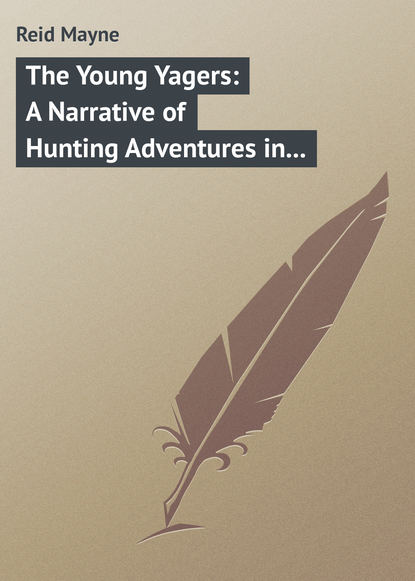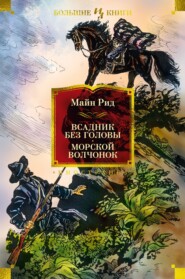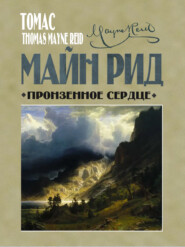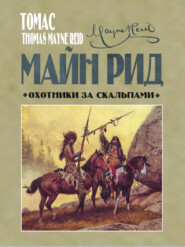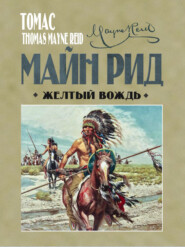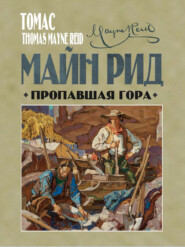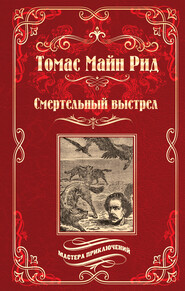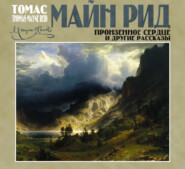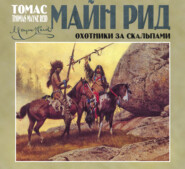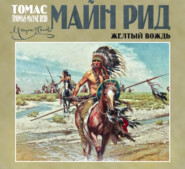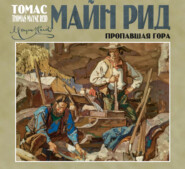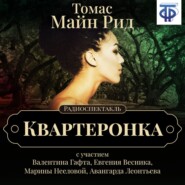По всем вопросам обращайтесь на: info@litportal.ru
(©) 2003-2024.
✖
The Young Yagers: A Narrative of Hunting Adventures in Southern Africa
Настройки чтения
Размер шрифта
Высота строк
Поля
The short thick Bushman and the tall lank Kaffir – both of whom had gone forth to the attack – were not a bit behind in the retreat; and the whole eight were mingled together in such a helter-skelter pell-mell race, as had never before been witnessed in that silent and solitary glen.
Chapter Forty Seven.
A Ride upon a Rhinoceros
Fortunately for all they were not distant from their wagons when thus charged upon. They had advanced only a few paces before delivering their fire, and these few paces were all they had to run back, before they sprang up into the capacious vehicles. Had it been otherwise – had the chase only lasted twenty yards farther – most undoubtedly one or more of the party would have been hoisted upon the horns of the pursuing animals, or trampled under their broad brutal hoofs.
As it was, the hindmost of them had a narrow escape of it; for they had hardly taken shelter under the cap-tents of the wagons, when the horns of the muchochos were heard rattling against the planks.
Although they had fled to the wagons for want of a better place, they were far from feeling secure. They knew that these immense brutes, should they take it into their heads, could soon demolish the vehicles, strong as these were. What was their consternation, then, at seeing the old bull suddenly lower his head, and charge forward upon one of the wagons, in which several of them had taken refuge!
The next moment was heard the terrible concussion – the horn of the muchocho struck the “buik plank,” passing clear through it – the timber split from end to end – the “achter kist” was shivered to pieces, and the huge vehicle was lifted clear from the ground, and hoisted several feet out of its place! A simultaneous cry of alarm broke forth from the occupants of the wagon – which was continued as they saw the huge quadruped preparing to repeat the charge.
At this crisis the faithful buck-dogs performed an essential service, and saved, not only the wagons, but perhaps also the lives of their masters. As the great bull was heading once more towards the wagon, several of the dogs attacked him from behind; two of them launched themselves upon his flanks, and one other springing upward, caught hold of his tail and hung on!
Now the tail of the rhinoceros is one of his tenderest bits; and this new and unexpected mode of assault quite disconcerted the old bull. Instead, therefore, of following up his charge upon the wagon, he turned round as fast as his unwieldy body would permit, blowing with agony and rage. But the stanch hound still hung on, while the others kept biting at the bull’s hind-legs; and vainly attempting to get at the dogs, the huge beast danced round and round like a kitten after its own tail – if a comparison may be allowed between two animals of such unequal magnitudes.
This scene continued for some minutes, until at length the dogs were thrown off. One of them was crushed beneath the heavy feet of the rhinoceros, while another was badly ripped by the horn of the female. But the gallant brutes had performed their part well; and by means of their barking and biting, they had drawn the muchochos altogether away from the wagons, and into a different part of the meadow.
It was not likely they would return to the attack upon the wagons, unless they chanced to be driven that way by the dogs – for the rhinoceros, partly from his low power of sight, and partly from his forgetful nature, rarely returns to assault any object once he has quitted it.
But a new fear now sprang up in the minds of the young yägers – no longer for themselves, but for their horses!
These animals, as already stated, along with the oxen, had been left grazing upon the meadow, without any fastening. When the muchochos first appeared, both oxen and horses had taken to flight. The oxen had gone toward the lower end of the meadow; and, guided by a cunning old leader, had set off upon their back trail over the ridge by which they had entered. The horses, on the contrary, had remained prancing around the wagons, until the muchochos came upon the spot; and, then dashing off together, had leaped the stream, and taken their stand trembling and cowering close by the cliffs on the opposite side. Here they had remained during the early part of the fight between the dogs and muchochos.
But in the course of this conflict both the dogs and their huge adversaries had worked up to the spot where the horses were, and once more set the latter in motion.
Seeing these, the rhinoceroses immediately started after them – perhaps deeming them antagonists more worthy of their horns; and now for some minutes a terrible mêlée of charging muchochos and galloping steeds filled the measure of the glen – the former blowing and snorting with rage, while the latter snorted with affright.
Fortunately, the small circumference within which this scene was enacted, enabled the hunters to use their pieces with effect; and whenever either of the rhinoceroses came to a stand, if but for a moment, the crack of a gun could be heard, and the thud of a bullet hitting against their thick hides. It is a mistake to suppose that a leaden bullet will not penetrate the skin of a rhinoceros. On the contrary, the hide, though thick, is comparatively soft, and yields easily to either a spear or a ball – so that every shot took effect. The hunters, par excellence, Hendrik and Groot Willem, fired most of the shots, aiming behind the fore-shoulder for the heart and lungs – for in these parts the shot proves fatal. A bullet into the brain would have a like effect; but as the brain of the rhinoceros is exceedingly small in proportion to the size of the animal, it requires a sure aim to strike it; and the more certain way is to aim for the lungs.
So aimed Hendrik and Groot Willem; and what with the large leaden balls of the roer, and the small but better directed pellets of the rifle, both the muchochos were at length made to bite the dust. The calf was shot afterwards; for after the fall of its parents, the creature did not attempt to run away, but stood by the body of its mother, jerking its little tail about, and wondering what the trouble was all about.
A very, ludicrous scene was now witnessed, that caused the young yägers to break into an uncontrollable fit of laughter. Their laughter, however, did not come until after the incident was over which gave rise to it – for there was danger in the scene, and it was somewhat painful to witness it.
It was as follows. The rhinoceros, like the American bison, when shot down by the hunter, rarely falls in the common way of other animals – upon its side – but usually sinks down upon his breast, and there remains even after death has taken place.
The two shot by Hendrik and Groot Willem had offered no exception to the rule. Both lay upon their bellies at a little distance from the wagons, their broad massive backs turned upward.
Now a practice equally common among Bushmen, whenever a rhinoceros has been killed, is to leap upon the animal’s back, thrust their spears into its flesh to try the depth, and discover whether the game be fat, and consequently valuable!
In the carrying out of this custom, no sooner had the great bull rhinoceros sunk down under the shots, than our Bushman, Swartboy, seeing that all danger was over, leaped forth from the wagon, and running up to where the dead animal lay, sprang upon its back! Shouting out a wild cry of triumph, he plunged his assegai into the flesh of the muchocho to the depth of a foot or more.
Almost at the same instant, the animal, which was not yet dead, rose to its feet again, and charged once more across the sward, with the Bushman upon its back!
The shout of triumph, which Swartboy had uttered, was suddenly interrupted, and cries of a far different import now rang through the glen; while the rhinoceros, no doubt impelled to fresh energy of life by the terrible pain he suffered from the Bushman’s spear, charged round and round, as though he had quite recovered!
Swartboy, on the other hand, dared not leap to the ground, lest he might be impaled upon the dread horns, but held fast to the spear, which, still buried in the animal’s thick flesh, served him as a point d’appui!
How Swartboy would have been delivered, had the strength of the muchocho held out, it is hard to say; but this gave way at length, and the huge quadruped once more sank to the earth, pitching the Bushman several yards over his head!
Swartboy did not lie long where he had been flung; but, sprawling up again, ran back at top speed to the wagons, where he was welcomed by yells of laughter! The oxen were soon overtaken and brought back, the calf of the muchocho regularly butchered, and that night the young yägers enjoyed a supper of “rhinoceros veal.”
Chapter Forty Eight.
Jan and the Koorhaans
The next camp of the young yägers was fixed in a beautiful valley very similar to that in which they had seen the troop of lions, but of larger extent, and having its whole surface enamelled with bright flowers.
There were mountains all around, that seemed to shut in this fair picture and protect it from the hot dry winds of the desert. A river wound through its midst like a silvery serpent; and here and there upon the pools, where there was not much current, rested the wax-like leaves and flowers of the blue lily of South Africa, (Nympha cerulea), Upon the plain grew trees and plants of various sorts peculiar to the botany of the country. The eyes of the travellers rested upon many a fair form. Upon the banks of the stream they saw the drooping fronds of the Chaldean willow; and by the foot of the mountain the splendid Acacia eburnea, with its umbrella-shaped head, and clusters of golden flowers filling the air with their fragrance. They saw the valuable wax-berry, (Myrica cerifera), yielding its clusters of white wax-coated fruit. They saw the perfumed “bead-bush,” out of whose fragrant roots are shaped the beads held in such esteem among the savage belles of the land. They saw the “sugar-bush,” (Protea mellifera), with its large cup-shaped pink and white flowers, – the most beautiful of the tribe of Proteaceae. There, too, were scarlet geraniums, with marigolds, and starry Cape jessamines, forming a garden in the wilderness pleasant to the eye and fragrant to the sense.
The songs of numerous birds fell upon the ear, and their brilliant plumage could be seen as they fluttered among the branches. The hum of bees, too, was heard; and thousands of these busy insects could be seen fluttering from flower to flower.
It was still early when the party arrived in this delightful spot; but so pleased were all of them with the scene around that they determined to halt before the usual hour and encamp there for the night.
So, choosing a pretty grove of willow-leafed “olean-wood” trees, that stood near the bank of the river, they outspanned under their shade.
As they were wearied by their exertions in getting the oxen over some rocky ridges, all lay down to rest under the cool shadow of the olean-woods; and several of the boys went to sleep, lulled by the sweet voices of the birds, the humming of wild bees, and the rushing sound of the water as it passed over some rapids below.
Klaas and Jan, however, had not gone to sleep with the rest, for neither had laid their shoulders to the wagon-wheels, and were, therefore, no more tired than usual. Besides, there was something nigh at hand that would have kept both awake, even had they been a good deal fatigued, and that was the appearance of a pair of very odd-looking birds out upon the plain, at no great distance from the wagons, and that every now and then raised their black top-knots above the grass and uttered a cry something like the croak of a raven.
These birds were not so very large – about the size of common fowls – but they were game-birds, having flesh of excellent flavour, and this rendered them interesting at the moment. They were, also, of very elegant forms – something of the tall majestic shape of the bustards. In fact, they were of a species that forms a sort of link between the bustards and grouse families; and are known in South Africa as “koorhaans,” and in India by the name of “floricans.”
But it was nothing of all this that rendered them so interesting to Klaas and Jan. It was that the latter knew a very curious method of capturing these very birds, and he was in a perfect fever to put it in practice right before the eyes of the rival bird-boy Klaas. In fact, ever since the day that Klaas had so distinguished himself by knocking over the klipspringer, Jan had been burning for an opportunity to perform some feat of equal pretensions, but none had turned up. Now that these birds – old acquaintances of Jan’s they were – had made their appearance, he saw a fair chance of gaining some renown. He would show Klaas how to catch koorhaans in a proper manner – that he would. So said Jan.
Jan was not long in having his triumph, which he obtained in the following manner.
He first pulled some long hair from the tail of his pony, which he twisted into a large stout snare. He next proceeded to Swartboy, and borrowed from the Bushman his whip, or rather the handle of the whip – for Swartboy took off the lash to accommodate him. It must be here remembered that Jan and Swartboy were great allies, and had been so for a long time; and it was in reality Swartboy who had taught Jan the curious mode he was about to practise upon the koorhaans. It must also be remembered that the handle of Swartboy’s whip was an immense affair – a bamboo cane, full eighteen feet in length, and more like a fishing-rod than a whip-handle.
Well, upon the end of this, where the lash had been tied, Jan adjusted his snare; and then, mounting his pony, rode forth upon the plain.
Klaas stood watching him; and upon Klaas’s countenance there was a puzzled expression that Jan did not fail to notice, and that delighted him exceedingly.
Klaas knew nothing about the modus operandi– could not guess how the other was going to act – and his ignorance betrayed itself, though he did not say a word.
Was Jan going to ride up and snare the birds? Surely they would not let him come so near? They appeared shy enough, and would not let him, Klaas, come within shot, for he had tried it but the minute before. No: it could not be that way – the koorhaans wouldn’t stand it, he knew.
Jan said nothing, but rode triumphantly forth, looking askance at Klaas as he passed out from camp.
When within about one hundred yards of the koorhaans – Klaas expecting every moment to see them run off as koorhaans usually do – Jan turned the head of his pony, and commenced riding round in a circle.
This he continued until he had got quite round the first circumference; and then, drawing his pony slightly inward, he began a second circle, which he completed as the first; and then still heading more inward, he made a third, and a fourth, and a fifth – of all which circles the bustards formed the centre. Of course, it was not exactly a circle he traced, but a spiral line constantly narrowing inward upon the game.
“Oho!” muttered Klaas, “I see what he’s after now. Oho!”
Klaas said nothing more; but remained watching with great interest, while Jan continued round and round like a blind horse in a brick-mill.
But Jan was not blind. He was watching the movements of the koorhaans with the sharp eye of a bird-catcher.





